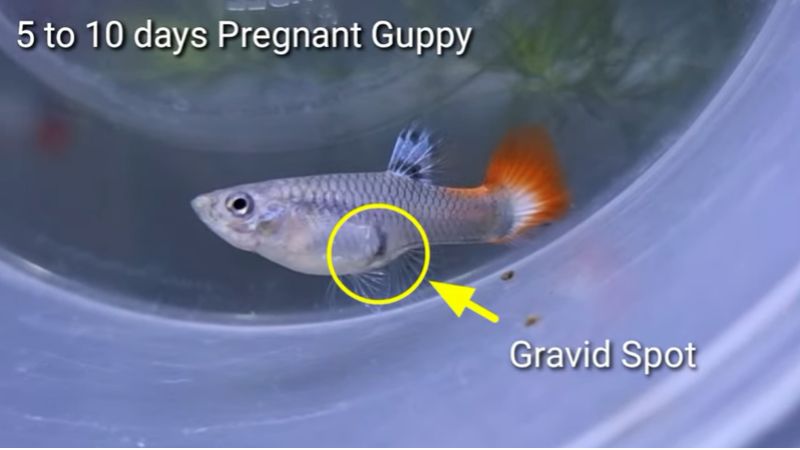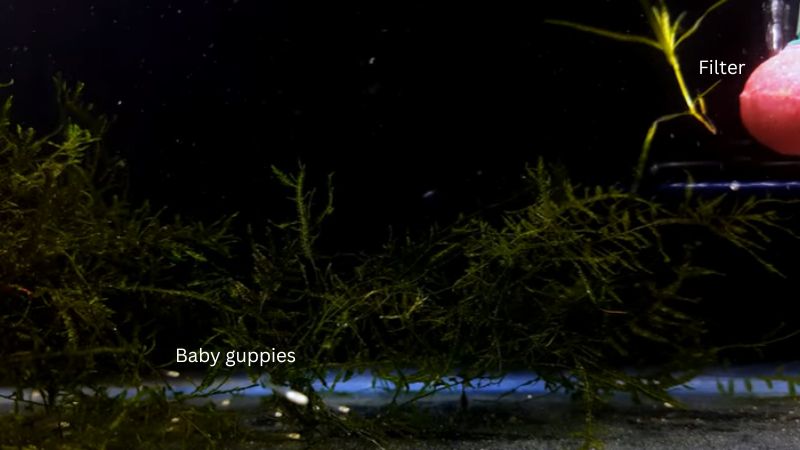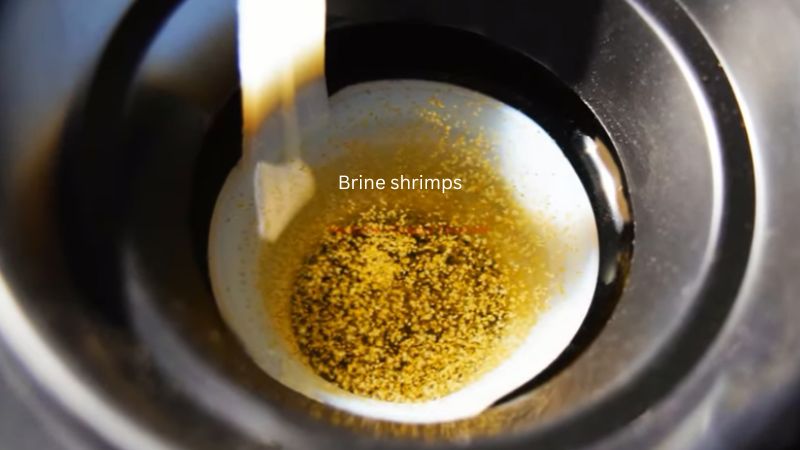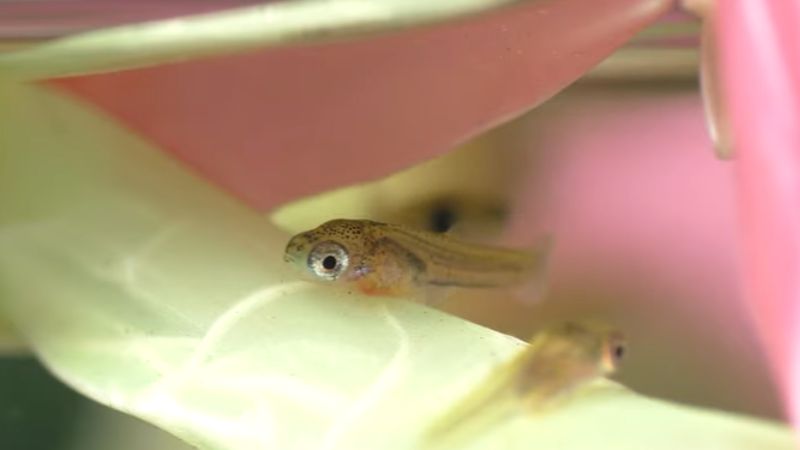One of the most well-liked and frequently kept freshwater fish. Guppies are renowned for their vivid colors, toughness, and simplicity of maintenance. Another popular activity among aquarists is raising guppies, and it’s easy to understand why. Baby guppies, also known as guppy fry, are wonderfully adorable and fascinating to see as they grow and change. To ensure the health and welfare of the guppies’ fry, guppy breeding operation and rearing them requires some knowledge and planning. Everything you need to know about guppy fry, including how to take care of them, what to feed them, and how to nurture them into healthy adult guppies, will be covered in this article.
How Are Guppy Fry Born?
When the female guppy is ready to release the fry, she typically hides. Before the guppy fry is born, the mother guppy may be in labor for a few hours (or maybe a few days). Once every 30 days are about how frequently they give birth till they are 2-2.5 years old. Guppies reach sexual maturity at about 4-6 months of age. Guppies do not lay eggs. Since guppies are livebearers, they deliver live fry. At a time, the mother guppy gives birth to 20–60 fries.
The guppy fry immediately begins to swim and will look for a hiding place in the tank. The fry is unresponsive and malformed at first. Within a few hours of birth, they are already skulking and looking for food.
How To Recognize Pregnant Guppy Fish?
It takes some practice to recognize a pregnant guppy. If you’ve put them in a breeding box so that they can give birth to baby guppies in the breeding tank, finding them will be harder. The body of the fish gaining more mass than usual is one clear indication that it is pregnant. Although the gravid spot’s deepening is a more reliable indicator of pregnancy in breeding guppies, you’ll need to pay closer attention to see it.
Separating the males from the females is a necessary step in the guppy breeding process. Guppies that are male are half as big as those that are female. The anal fins of the males are similarly longer and slimmer. Contrarily, female guppies have anal fins that are triangular with a gravid patch right above the anal fin.

Now you need the eyes of a hawk for observation if you want the fry guppies to be born in the community tank. The bodies of the pregnant women eventually collide in the abdomen, appearing as though they would explode at any moment.
Guppy Fry Tank
Adult guppies don’t care for their young because they lack maternal impulses, unlike mammals. You are totally responsible for the guppy fry’s survival. A correct aquarium setup is a fantastic place to begin.
Let’s start by discussing the tank size. Here, there is no one solution that suits everybody. The size of the aquarium is determined by how many guppies you intend to keep. The ideal tank size should be 10 gallons. You’ll need a larger aquarium if you want to keep five or more baby guppies there.

The straightforward reasoning is that since the kit includes all the necessary accessories, you may start setting up right away.
The following equipment is required:
- Lights: The right lighting is yet another area that needs deliberate attention. Recall that guppy fish are nocturnal. They require complete darkness at night and sufficient light during the day. See the pattern of day and night. The norm for aquarium lighting is LED. They have a number of advantages, including cost, toughness, and little to no heat production. Nothing should affect the water’s temperature, please.
- Filter: A filter for an aquarium is necessary because it serves two essential purposes. It promotes waste removal and the development of wholesome bacterial colonies. The number of guppy babies in the aquarium will determine the size and kind of filter you need. The production of garbage increases as they multiply. If your tank is small, I advise a sponge filter. Consider a hang-on-back one if it’s a medium-sized one.
- Heater: To keep the water at the suggested 75°–80° F, you’ll need a heater. Atmospheric temperatures can fall below freezing during the colder months. The heater will return the water’s temperature to its ideal range because such elements will have an impact on it.
- Separate breeding tank: There is no exact answer to the question, “Do guppy fries need to live in separate tank?” it depends on personal needs. The adult guppies must not be stressed out in order for the guppies fry to coexist in the same tank as them. Make sure they are not acting aggressively because this could encourage them to start feeding on anything that will fit in their mouths, and guppy newborns are no exception.
- Contaminated: Guppy fry routinely swimming at the bottom of the tank is one indication that you might have seen but failed to recognize. Like us, fish make every effort to keep as far away from pollution as they can. Several cases of illness or possibly many deaths are another indicator. Please do not wait until there are more obvious contamination symptoms because by then, it might be too late to undo the damage. Unless you utilize a larger tank or numerous tiny tanks for your fish, clean the tank once a week.
Water conditions for guppy fry
The foundation of guppy fry care, like that of other aquatic pets, is a clean environment. The lifespan of your infant guppies is significantly increased by maintaining high water quality. Excellent hygiene within the fish tank is a commendable step in caring for guppy fry.
The time it takes to change filters and water increases with tank size. The advantage is that larger enormous tanks take longer to pollute since they have more room. Keep the newborn guppies in a separate tank to further limit waste. Guppy fry is harmed by chlorine because it harms their delicate gills. In reality, chlorine is harmful to all fish in high amounts.
How to oxygenate for guppy fry?
Like all other fish, guppy fry requires oxygen to survive. Owners of guppy fry have little choice but to maintain a steady supply of well-oxygenated water. Water naturally contains oxygen, but occasionally the amounts are insufficient to sustain life and must be maintained at high levels.
Use air stones and gentle pumps to aerate the tank. Living aquarium plants, such as guppy grass, are an effective technique to maintain the water oxygenated and remove dangerous wastes from the tank, such as ammonia and nitrate, in the aquarium water.
For more seasoned owners, manual aeration might be effective. Manual water exchange is not advised when the most delicate fish fry is within. The baby guppies may fear adding water to the tank, just as sharp air stones irritate the fish.
What To Feed Guppy Fry?

If you don’t have easy access to these live foods, baby brine shrimp, vinegar eels, micro worms, and flakes food will do. For more experienced owners, manual aeration might be effective. Manual water exchange is not advised when the most delicate fish fry is within. The baby guppies may fear adding water to the tank, just as sharp air stones irritate the fish.
Another excellent source of protein for fries is egg yolk. Make a paste with the yolk of a hard-boiled egg. Twice a day daily, add small amounts to your fries.
A newborn guppy fry is about 6 mm long, and it also has a relatively small mouth. Guppy fry will consume whatever their parents, who are adults fish, will eat. Make sure to crush the food before giving it to them so that it will fit in their mouth. In order to avoid choking or harming your digestion, baby guppies must also be eaten in little portions.
This feeding schedule might be maintained if you are operating a profitable guppy breeding business. However, feeding the fry once a day is sufficient if you are raising guppies for fun.
Some Tips When Raising Guppy Fry
Although it can be a rewarding and pleasurable experience, raising guppy fry also calls for some perseverance, commitment, and focus on the small things. The secret to effectively rearing healthy guppy fry is to give them the right habitat, the right food, and enough care. Here are 02 tips that can make your raising guppy fry experience easier.
How to help guppy fry grow faster?
Do you, as a breeder, feel satisfied when your offspring achieve milestones? Breeders and parents of guppy also adore these instances.
Let’s start by determining why their growth sometimes becomes stagnant.
- Insufficient or too much water volume.
- Low dietary variety and poor nutrition.
- Keep the adult guppies and the fry in a separate tank.
There are some important things that you can do:
- Make sure they have enough room and the right amount of water by separating them based on size and gender. Add some live plants like java moss and change the water twice a week.
- Provide your pet with a balanced diet that includes a range of foods.
- As soon as you see any symptoms of a disease, treat them.
- Weekly water changes and ongoing tank maintenance.
- Regularly clean and replace filters.
- Allow them to relax for roughly eight hours in the tank’s darkness.
Equipment to breed guppy fry
Many breeders separate pregnant females into small containers they use for breeding tanks. The newborn fry falls through small mesh openings in the trap and can live safely in the breeding container during the birthing process and after the trap with the mother is removed.
FAQs
How many baby guppies grow into adulthood?
According to certain breeders, up to 50% or more of the fry survive and mature into adults. The proportion of newborn guppies that survive to become adults can vary depending on a number of variables, including the well-being of the parent guppies, the water’s quality, and the quantity of care given. It’s crucial to keep in mind, too, that guppies are known to have a lot of young, and overcrowding can develop fast if the fry is not separated or culled as necessary.
How to save your guppy fry?
You can quarantine your guppy fish in a separate tank, maintain good water quality with frequent water changes, and give it a varied and nourishing diet to prevent disease or suffering. Provide medication as directed by a veterinarian or seasoned aquarist, if necessary. By providing a suitable environment with hiding spots and appropriate lighting and avoiding overpopulation or aggressive tank mates, you can lessen stress in your guppy fish. You can raise your guppy fish’s chances of recovery and improve its general health by following these instructions.
Water temperature for guppy fry?
Tropical fish like guppy require a temperature of 78–80°F (25–26.5°C) is ideal. This temperature range promotes the growth and development of guppy fry and inhibits the development of pathogenic microorganisms and parasites. It’s crucial to remember that abrupt temperature changes can be stressful for guppy fry and even result in serious health issues or even death.
References:
- Guppy Channel – https://www.youtube.com/@GuppyChannel
- Freshwater Fish Wiki – https://freshwaterfish.fandom.com/wiki/Guppy

Annette M. Chaney is an experienced marine biologist with over 20 years of experience as an aquarist and fishkeeper. She started her first aquarium at a young age, filling it with frogs and goldfish obtained from the ten-cent pet store.
Annette grew up caring for and breeding African Cichlids, which led to a hobby in high school that doubled as a profitable means. Attending Reed College gave her time to solidify herself as an accomplished aquarium caretaker with an eye for sales. After that, from 2009 – 2013, she studied at Roger Williams University – one of the most prestigious universities for Aquaculture and Aquarium in USA. She is the founder of AquariumCircle since 2010.
